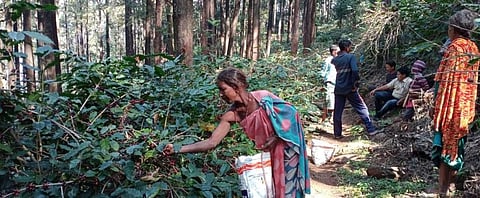

Coffee farming is transforming the hilly tribal-dominated villages of Odisha’s Koraput district. It is bringing about a qualitative change in the lives of around 5,000 tribal families.
Koraput district, located at a height of 3,000 feet above sea level, is ideal for coffee cultivation due to its cool climate and rainfall.
Upendra Kumar, the senior liaison officer of the Coffee Board of India under the Union Ministry of Commerce and Industry at Koraput, said:
Coffee cultivation is a viable alternative to podu or shifting cultivation for the tribals of Dasabantapur, Laxmipur, Nandapur, Similiguda and Patangi blocks of the district.
Tribals in Korapurt had a number of reasons to prefer coffee over podu, according to Saha.
Coffee growers had a large scope for profit as they harvested 160 kilograms of clean coffee per hectare. The rate of a kilogram of coffee fruit was Rs 35, whereas the price of a kilo of clean coffee was Rs 210.
The best thing about coffee farming was its low maintenance and low cost factors, Saha noted.
“We provide coffee seeds to the farmers to grow coffee plants. A coffee plant takes four years to grow and each year, farmers harvest coffee fruits from the plants,” he said.
The total area under coffee cultivation in Koraput has increased because of the lucrative prices the farmers received for the last produce.
Coffee was cultivated on 2,000 hectares of land seven years ago. This had now increased to 5,000 hectares.
Roshan Karthik, chief executive officer of Odisha Rural Development and Marketing Society Koraput, said his organisation had formed 40 producer groups in the district to sell coffee after collecting from farmers.
“This area was infamous for migration. But now, we have managed to halt migration to a great extent in this region as people earn a good amount by raising coffee plants,” Kartik added.
A number of farmers said their experience with cultivating coffee had been a positive one.
“In 2014, I started coffee farming for the first time. For me, it was a new crop whose outcome I wasn’t aware of. We tried out with one hectare of cultivation and made a profit of Rs 60,000 in a year,” Jiban Paraja, a 45-year-old from Nandapur village, said.
Nira Gomanga, who grows coffee on a hectare of land in Dasbantapur village, said:
My interest was ignited in 2016 when officials urged me to start coffee farming. Many farmers in neighbouring Andhra Pradesh were earning good money by doing so, they said.
Gomanga was convinced tried his hand after getting financial support from the Tribal Development Cooperative Corporation of Odisha Ltd (TDCCOL).
“Now, I am earning around Rs 60,000 per year from my plot of land,” he says.
Babaji Sagaria, 45, of Patangi village was a poor farmer six years ago. Now, he earns around Rs 150,000 per year by farming coffee on his two hectares of land.
Chief Minister Naveen Patnaik inaugurated the Koraput Coffee Cafe on International Coffee Day October 1, 2021. He also dedicated an e-commerce platform (Koraputcoffee.org) to promote Koraput coffee across the globe.
Patnaik said the state government was planning to set up a number of such cafes across the country to establish the brand and transform the lives of local cultivators.
He noted that the TDCCOL now marketed Koraput coffee. This year, the Coffee Development Trust at Koraput had also taken over 300 hectares of new and old coffee plantations.
“Tata Coffee has recently agreed to market coffee grown in the Koraput district in national and international markets,” Mansi Nimbhal, managing director of TDCCOL, said.